My Blog - Jeff Clarke
Updates and photos from around the world on my travels both through pleasure and work
'Black Watch' - Sector Five (Part 1 Australia)
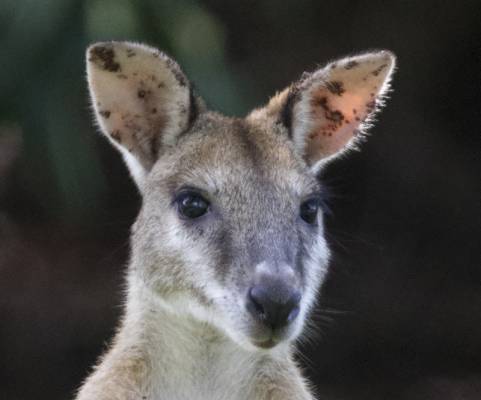
As a wildlife speaker on cruise ships I have the good fortune to visit some of the best places on the planet for indulging my passion for nature. I also use the opportunities I get to pursue two of my personal goals, namely seeking out ‘tubenoses’, a specialised group of seabirds that includes shearwaters, petrels and albatrosses, as well as plying cetacean rich waters in the hope of spotting all the known species.
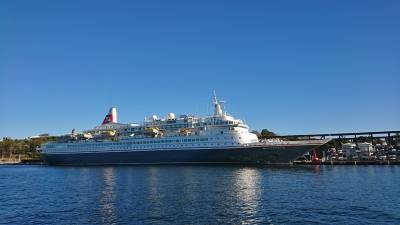
Black Watch berthed in Sydney Feb 27th 2018
Click on images to view at full size.
On this tour I joined the Fred. Olsen Cruise Lines ‘Black Watch’ in Sydney, for the 5th sector of its ‘Wonders of the Word’ circumnavigation, on the 27th Feb 2018. I was accompanied by my wife Adele, who shares my passion for dolphin and whale watching.
Following a superb guided tour of the internal areas of the iconic Sydney Opera House, Adele and I, together with our expat friend Jane, strolled through the equally impressive Botanic Gardens. Sydney has an inbuilt replacement for the familiar feral pigeon in the shape of the rather more exotic Australian White Ibis. These adaptable birds are equally at home on a traditional wetland, a rubbish tip, or the café tables in the heart of the city. The Laughing Kookaburras are also rather adept at exploiting human folly, including snatching tasty morsels right off the plate of unwary snackers.
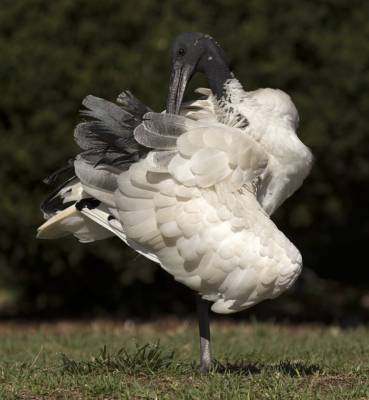
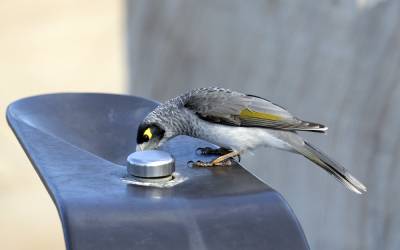
Australian White Ibis and Noisy Miner © Jeff Clarke


Rainbow Lorikeet & Pied Currawong © Jeff Clarke
Little had changed since my last visit in 2012, the parks and gardens were full of birds like Noisy Miners, Rainbow Lorikeet’s, Magpie Larks and Pied Currawongs.
By late afternoon on the 28th we began our journey northwards and when we reached ‘The Heads’ at Manley we began picking up the first of thousands of Wedge- tailed Shearwaters to be seen during our journey.
The following morning I delivered the first of my lectures, which focused on the whales and dolphins that we could encounter during this sector of the cruise. Inevitably somebody had a whale ‘fluking’ off the port side whilst I gave my lecture - such things are almost a ‘given’. Thankfully I did manage to locate Bottlenose, Risso’s and Spinner Dolphins during the day.
Apart from the Wedge-tails there were also Fluttering Shearwaters periodically crossing the bow alongside the occasional Grey-faced Petrel, two of which were dead-ringers for Great-winged Petrel. Both are the subject of a recent taxonomic split. 3 Red-tailed Tropicbirds were never close enough even for ‘record shots. Fortunately the Red-footed Booby posed no such problems, it was however in an unfamiliar colour morph. Easily mistaken for Blue-footed Booby.
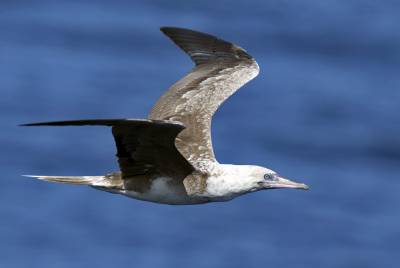
Red-footed Booby © Jeff Clarke
The following morning we docked in Brisbane, some distance outside the city. The berth overlooked an interesting area of mangrove and wetland. Views were distant, but I could see large flocks of Red-necked Avocets, Black necked Stilts, Australasian Pelicans and even an Eastern Curlew.
A ‘shuttle-bus’ ride later and we were partaking of a river cruise on a small launch. We had been waved off at the wharf by a delightful Welcome Swallow. We broke our journey at a small park surrounding Newstead House where I indulged my photographic urges on a garrulous flock of Little Corella. My first encounter with this down-sized Cockatoo. I also notched up my first images of Blue-faced Honeyeater and Pied Butcherbird.
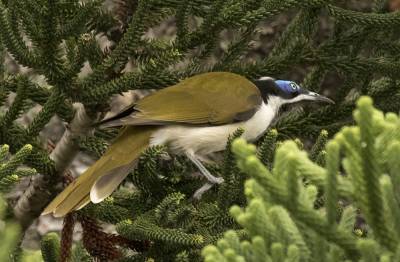
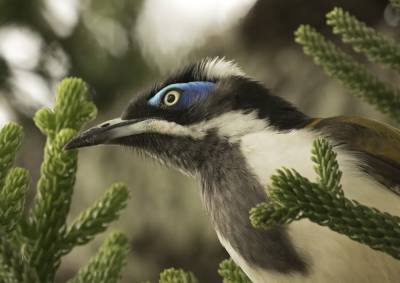
Blue-faced Honeyeater © Jeff Clarke


Pied Butcherbird & Welcome Swallow © Jeff Clarke

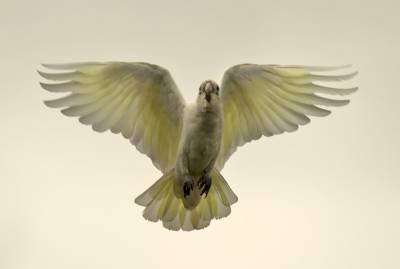
Little Corella @ Newstead House, Brisbane © Jeff Clarke
After lunch we strolled through the fabulous Brisbane Botanic Gardens. A movement in the mangroves caught my eye and despite the deep shade I managed an acceptable image of a furtive Buff-banded Rail. Just like most of the birds, the Eastern Water Dragons, a type of lizard that frequented the various pools, seemed entirely unphased by human approach. This seems to be a consistent feature of the wildlife around Australia’s botanical gardens.

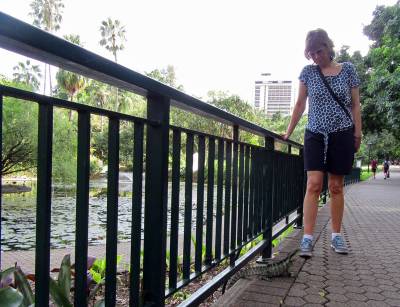
Buff-banded Rail & Adele meets the Eastern Water Dragon © Jeff Clarke
The following morning I carried out the first of my Wildlife Deck Watches, as we pressed on northwards toward the Great Barrier Reef. I had a good crowd, all hyped up by my talk on the previous sea day. The pressure was on to produce the goods! I need not have worried, within 10 minutes of starting I spotted a breach in the distance and soon we were enjoying the spectacle of a dispersed pod of False Killer Whales. These were quickly followed by a pod of bow-riding Spinner Dolphins.
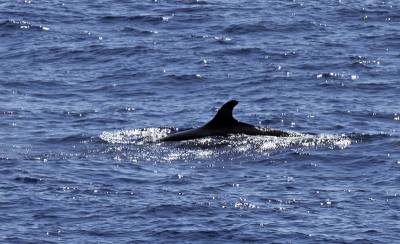
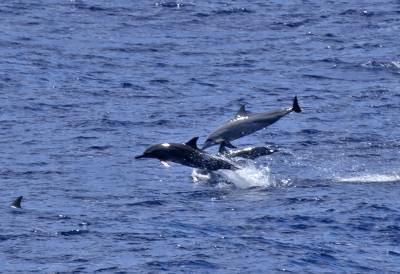
False Killer Whale & Spinner Dolphins © Jeff Clarke
The birds were equally impressive with several Tahiti Petrels crossing ahead of the ship and a male Great Frigatebird giving us the once-over. More Red-footed Boobies opportunistically zoomed around the Black Watch chasing down the myriad Flying Fish disturbed by the ship’s approach.
The following morning we spent several hours snorkelling on the Great Barrier Reef off Hamilton Island. I didn’t take my Go Pro, so no photos but it was a brilliant experience. Evidence of 2016’s mass bleaching event was still apparent in places but the reef had recovered to some degree. Definitely a recommended activity for anyone passing this way.
We pushed on north for the next two days toward the Torres Strait, periodically spotting sea snakes and the odd pod of apparent Indo-Pacific Bottlenose Dolphins that seemed reluctant to bow-ride.
A big feature of this leg of the trip were, of all things, a species of pigeon. As dusk approached we would get flocks of Pied Imperial Pigeons crossing Black Watch’s bow as they hurried from the mainland rainforest areas to roost on the offshore islands of the reef.
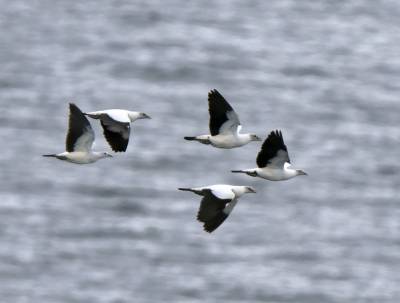
Pied Imperial Pigeons off the Great Barrier Reef © Jeff Clarke
We were also encountering large numbers of terns. Brown Noddies dominated proceedings, but they were backed up by many Bridled, Sooty, Crested and Roseate Terns.

Bridled Tern juvenile © Jeff Clarke
We eventually turned the corner into the Arafura Sea. Here we encountered our first Streaked Shearwaters, I blithely assumed it would be easy to get decent photographs. I was wrong! This proved to be a frustrating couple of days, what little we did see was almost always at distance from the ship, including two rorqual whale blows. Closer to hand were many ‘tuna boils’ and one of my pictures suggests the species involved was Long-tailed Tuna, we never had any cetaceans associating with them.
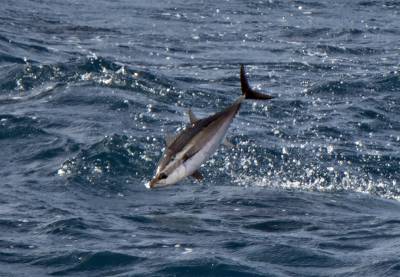
Long-tailed Tuna, Arafura Sea © Jeff Clarke
On the 9th we docked in Darwin. I’d hired a professional naturalist guide, Luke Paterson of NT Bird Specialists for what would be one of the highlight days of the entire tour. Adele and I were joined for the day by fellow cruise passengers Bill and Carolyn Archdeacon. A couple of spontaneous roadside stops aside, for the likes of Australian Hobby, we headed initially for the East Point Reserve. The Agile Wallabies were unmissable as they bounded across the reserves grassy areas. Birds were equally abundant, but photography was a challenge. I managed passable record shots of the Rainbow Bee-eaters a flyby Pacific Baza, White-breasted Woodswallow and Varied Triller.

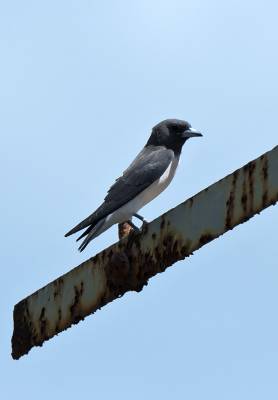
Jeff travelling light © Adele Clarke & White-breasted Woodswallow © Jeff Clarke
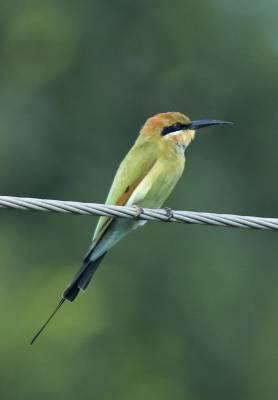

Rainbow Bee-eater & Agile Wallaby © Jeff Clarke

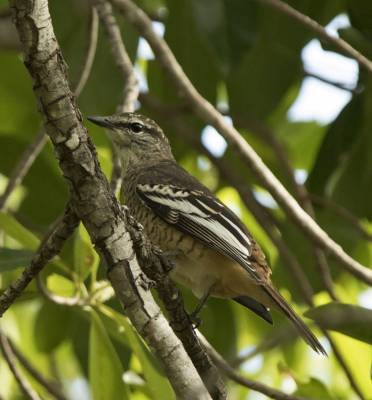
Pacific Baza & Varied Triller (female) © Jeff Clarke
The reserve is a good location for the Orange-footed Scrubfowl, a megapode that constructs vast, heat-generating, mounds to incubate its eggs. Though the dense shade and dappled light made it hard to record their labours with an acceptable image.
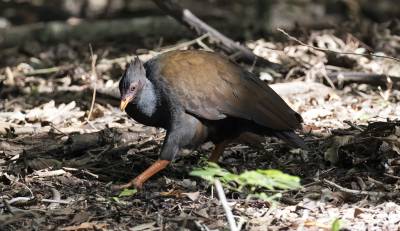
Orange-footed Scrubfowl © Jeff Clarke
During a snack for elevenses I savoured the large flocks of waders gathered on the rocky shore. It was a smorgasbord. The dominant species was the Great Knot, backed up with Lesser and Greater Sand Plovers, a few Terek Sandpipers and Sooty Oystercatcher. The sun was in a difficult position for photography and, not wanting to disturb them, I settled for a few distant shots.
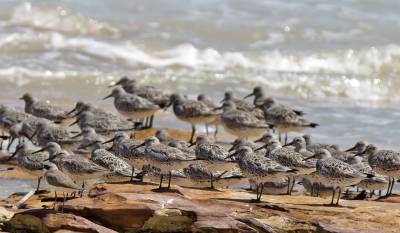

Great Knot at East Point Reserve, Darwin © Jeff Clarke
After lunch Luke 'winkled out' a few more gems around the reserve, the Bush Stone-curlews being a particular highlight, alongside ‘Yellow’ Figbird, Lemon-bellied Flycatcher and Northern Fantail. The latter was quite a lethargic, lumpen thing compared to the hyperactive Grey Fantails I’m used to seeing.


'Yellow' Figbird & Bush Stone-curlew © Jeff Clarke
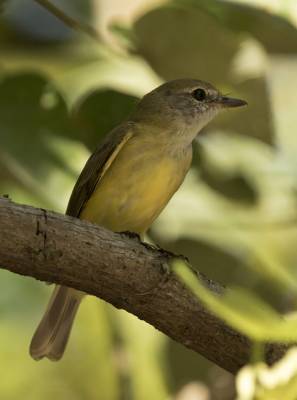

Lemon-bellied Flycatcher & Northern Fantail © Jeff Clarke
Next stop the Botanic Garden. One small tree was alive with frenetic Brown and Dusky Honeyeaters that duly frustrated my photographic attempts.
Redemption came moments later in the form of a ‘much desired’ bird, as the ghostly apparition of a Grey Goshawk resolved itself, high on a perch, in a shading Eucalypt. I allowed my demeanour of quiet concentration to take a break, as a big beaming smile rearranged itself on my face. It returned spontaneously again a short while later as Luke homed us in on a pair of roosting Rufous Owls. These two sightings were intersected by a canopy patrolling juvenile Brahminy Kite. Getting a photograph of it in the gaps between the trees was a challenge but eventually I got a passable image.
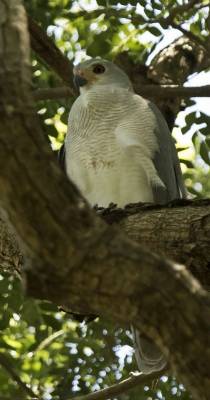
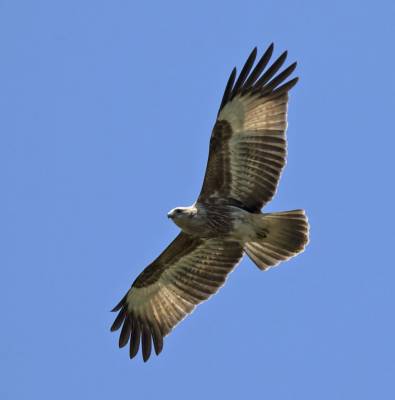
Grey Goshawk & Brahminy Kite © Jeff Clarke
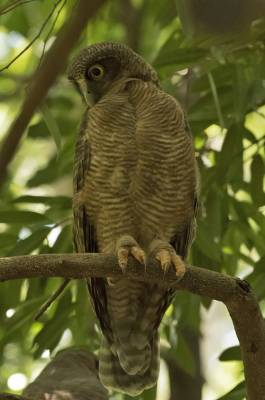
Rufous Owl © Jeff Clarke
Masked Lapwings seem to abound on any grassy areas in Australia’s botanic gardens and Darwin’s were no different, the birds here looked markedly different from those present in Sydney and the explanation was simple, they are a separate sub-species. They are possessed of oversize facial wattles compared to their south-eastern cousins, but share the same feistiness when their eggs, or young, are threatened.
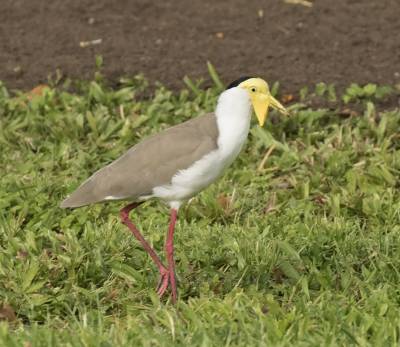
Masked Lapwing race 'miles' © Jeff Clarke
By the time we reached Howard Springs the heat and humidity had achieved their zenith. We lunched in a shady spot. The hoped-for Rainbow Pitta’s resolutely refused to give themselves up. The comedy moment of the day occurred when the Black Flying Foxes we were watching were abruptly forgotten when we realised we were becoming the target of numerous little black leeches. Leeches, it seems, are not popular.
As we wended our way back towards the ship Luke stopped in an urban parkland area and set off for a wooded slope. A short time later he located our final major prize of the day in the form of a pair of Barking Owls, after a short time we left them in situ. A short search for Tawny Frogmouth drew a blank, but compensation came in the shape of a Brush-tailed possum snuggled in the fork of a small tree.
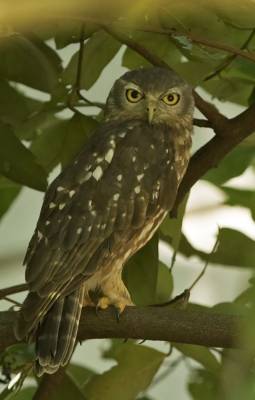

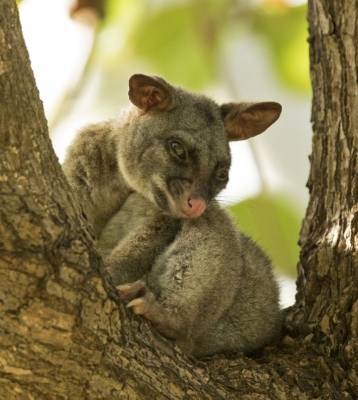
Barking Owls & Brush-tailed Possum © Jeff Clarke
We returned to the ship, delighted with our Darwin adventure, our day with Luke was full of great wildlife and he proved to be a ‘top bloke’. If you want a really good days birding in Darwin, then I’d thoroughly recommend NT Bird Specialists.
As we sailed out of Darwin, Australia receded into the distance but we would take with us many wonderful and indelible memories.
Next stop Komodo Island…
http://www.jeffclarkeecology.co.uk/blog/black-watch-sector-five-part-2-komodo-an-beyond
Acknowledgements:
I would like to thank the following organisations and individuals: my agent Peel Talent (in particular Daphne Franks); Fred Olsen Cruise Lines; The Crew of ‘Black Watch’; my fellow speakers and entertainers for their comradely friendship and support; and most of all my wonderful wife, Adele.
This blog is dedicated to the memory of our friend Jonathan Rafter. Jon was to be my original companion for this cruise. His sudden and unexpected death hit all his friends hard. He is greatly missed. Adele and I thought of him often during this trip.

